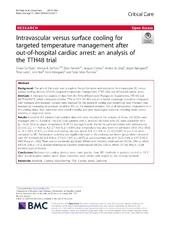| dc.contributor.author | De Fazio, Chiara | en_US |
| dc.contributor.author | Skrifvars, Markus B. | en_US |
| dc.contributor.author | Søreide, Eldar | en_US |
| dc.contributor.author | Creteur, Jacques | en_US |
| dc.contributor.author | Grejs, Anders Morten | en_US |
| dc.contributor.author | Kjærgaard, Jesper | en_US |
| dc.contributor.author | Laitio, Timo | en_US |
| dc.contributor.author | Nee, Jens | en_US |
| dc.contributor.author | Kirkegaard, Hans | en_US |
| dc.contributor.author | Taccone, Fabio Silvio | en_US |
| dc.date.accessioned | 2020-08-13T12:59:18Z | |
| dc.date.available | 2020-08-13T12:59:18Z | |
| dc.date.issued | 2019 | |
| dc.Published | De Fazio, Skrifvars MB, Søreide E, Creteur, Grejs AM, Kjærgaard J, Laitio T, Nee J, Kirkegaard H, Taccone FS. Intravascular versus surface cooling for targeted temperature management after out-of-hospital cardiac arrest: An analysis of the TTH48 trial. Critical Care. 2019;23:61 | eng |
| dc.identifier.issn | 1466-609X | |
| dc.identifier.issn | 1364-8535 | |
| dc.identifier.uri | https://hdl.handle.net/1956/23746 | |
| dc.description.abstract | Background: The aim of this study was to explore the performance and outcomes for intravascular (IC) versus surface cooling devices (SFC) for targeted temperature management (TTM) after out-of-hospital cardiac arrest. Methods: A retrospective analysis of data from the Time-differentiated Therapeutic Hypothermia (TTH48) trial (NCT01689077), which compared whether TTM at 33 °C for 48 h results in better neurologic outcomes compared with standard 24-h duration. Devices were assessed for the speed of cooling and rewarming rates. Precision was assessed by measuring temperature variability (TV), i.e., the standard deviation (SD) of all temperature measurements in the cooling phase. Main outcomes were overall mortality and poor neurological outcome, including death, severe disability, or vegetative status. Results: A total of 352 patients had available data and were included in the analysis; of those, 218 (62%) were managed with IC. A total of 114/218 (53%) patients with IC and 61/134 (43%) with SFC were cooled for 48 h (p = 0.22). Time to target temperature (≤ 34 °C) was significantly shorter for patients treated with endovascular devices (2.2 [1.1–4.0] vs. 4.2 [2.7–6.0] h, p < 0.001), but temperature was also lower on admission (35.0 [34.2–35.6] vs. 35.3 [34.5–35.8]°C; p = 0.02) and cooling rate was similar (0.4 [0.2–0.8] vs. 0.4 [0.2–0.6]°C/h; p = 0.14) when compared to SFC. Temperature variability was significantly lower in the endovascular device group when compared with SFC methods (0.6 [0.4–0.9] vs. 0.7 [0.5–1.0]°C; p = 0.007), as was rewarming rate (0.31 [0.22–0.44] vs. 0.37 [0.29–0.49]°C/hour; p = 0.02). There was no statistically significant difference in mortality (endovascular 65/218, 29% vs. others 43/134, 32%; p = 0.72) or poor neurological outcome (endovascular 69/218, 32% vs. others 51/134, 38%; p = 0.24) between type of devices. Conclusions: Endovascular cooling devices were more precise than SFC methods in patients cooled at 33 °C after out-of-hospital cardiac arrest. Main outcomes were similar with regard to the cooling methods. | en_US |
| dc.language.iso | eng | eng |
| dc.publisher | BioMed Central | eng |
| dc.rights | Attribution CC BY | eng |
| dc.rights.uri | http://creativecommons.org/licenses/by/4.0 | eng |
| dc.title | Intravascular versus surface cooling for targeted temperature management after out-of-hospital cardiac arrest: An analysis of the TTH48 trial | en_US |
| dc.type | Peer reviewed | |
| dc.type | Journal article | |
| dc.date.updated | 2019-12-10T18:43:27Z | |
| dc.description.version | publishedVersion | en_US |
| dc.rights.holder | Copyright 2019 The Author(s) | |
| dc.identifier.doi | https://doi.org/10.1186/s13054-019-2335-7 | |
| dc.identifier.cristin | 1703554 | |
| dc.source.journal | Critical Care | |

